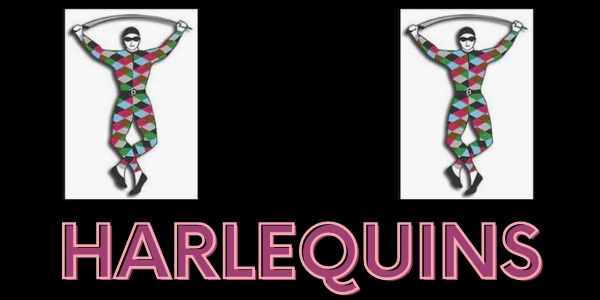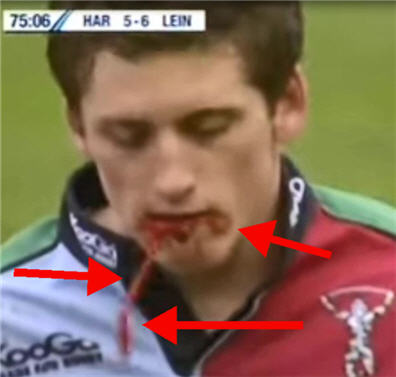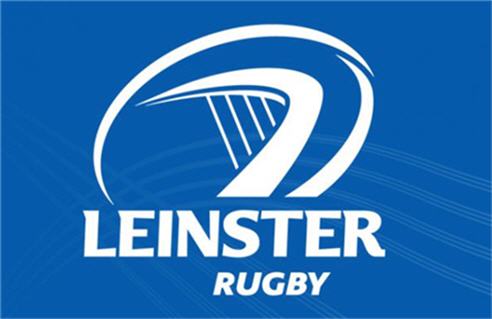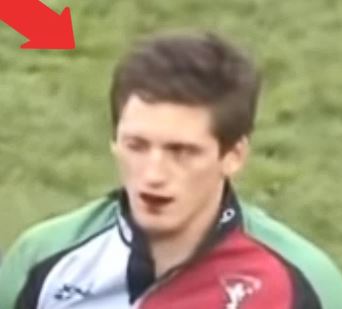Harlequins Bloodgate refers to an infamous event in which the rugby club’s winger feigned injury by biting on a fake blood capsule bought in a joke shop.
This article tells you what exactly happened, why Harlequins did it, and what was the fallout. Parts of Bloodgate were so farcical that it’s hard not to laugh. But there was a very serious side to it too.
The Background To Bloodgate

Why would a rugby player fake an injury by biting on a fake blood capsule?
Before we look at the extraordinary events of Bloodgate, we should look at the reasons that led up to it. The key is to understand how permanent and temporary substitutions work in rugby.
Unlike soccer, substitutions are a relatively recent part of rugby. They weren’t officially allowed until the late 1960s.
Tactical substitutions
Up until 1996, substitutions in rugby could only be for injury. The laws were changed to allow three tactical substitutions.
The team staff must inform the match officials whether a substitution was for injury or was tactical.
Another important point about tactical subsitutions is that the player is allowed return to the field as a replacement for a blood injury. This little point will become important later in the tale!
What Happened In Harlequin’s Bloodgate?

In 2009, Harlequins met Leinster in the quarter-final of the elite club European championship. The tournament has had various names, but it’s commonly known as the Heineken Cup.
Both teams were vying to win the European championship for the first time in their history. Harlequins had the slight advantage of playing at home on their London grounds. Leinster traveled from Dublin.
The tightest of scores
The match went down to the wire. Leinster scored two unanswered penalties in the first half to go into the changing rooms with a six-point lead.
But Quin’s renowned fullback Mike Brown scored an unconverted try to bring his team back to within a point. The score was 5-6 as full-time approached.
Harlequins unfortunate injuries
Harlequins were unlucky with injuries throughout the match. Although it was a choice by their coach to start a player who was recovering from a previous leg injury.
But that player was New Zealand fly half, Nick Evans, one of their stars. Evans picked up a thigh injury in the second half. He hobbled off the pitch, grimacing in pain.
Injuries are common in rugby, but it’s rare that a replacement also gets injured. The Quins replacement fly half pulled his hamstring. He had to go off with about ten minutes to go.
Fullback Mike Brown was not a specialist placekicker, but he now had to take the penalties. He duly missed one with eight minutes to go.
“My kingdom for a fly half”
Richard the III shouts “my kingdom for a horse” in Shakespeare’s play. I imagine that coach Dean Richards felt similarly about getting a flyhalf onto the field.
Leinster had kept Harlequins to zero points in the first half, and a single unconverted try in the second. Their defense was about to win the game. Quins’ best hope was a drop goal.
But Quins didn’t have a specialist kicker on the field. Their scrumhalf, Danny Care, pushed a drop goal attempt wide of the posts.
Injury or tactical substitution?
Although Nick Evans had an injured thigh, the coach bet the kingdom on his sharpshooter. If the forwards could get into a good position, all Evans would have to do is stand still, grimace, and kick a drop goal.
But Evans had apparently gone off with an injury. Even the commentators thought so (I was watching the match on television at the time).
Under the laws of substitution, he would not be allowed to return to the field.
It turned out that the Harlequins staff had laid the groundwork for the big switcheroo. When Evans went off injured, the staff told the match officials that it was a tactical substitution.
The “blood” injury
With five minutes to go and Harlequins down by a point, the ball went dead.
Suddenly, a Harlequins winger went down “injured”. The physio raced on to the pitch to bend over Tom Williams, the young winger.
Meanwhile, the television cameras turned to fly half Nick Evans. He standing at the side of the pitch, tracksuit off and ready to come back onto the field.
The cameras switched back to the physio walking the “injured” winger off the field. The player was spitting large amounts of “blood” out of his mouth.
Here’s a still that I helpfully marked up (yeah, you don’t need the arrows!):

I was watching on television and was startled by the red smears on his face. It didn’t look like any other blood injuries I’d seen.
The tactical sub
The referee was Nigel Owens, one of the best in the game. He was hardly unlikely to notice that an injury sub was returning to the field. He went over to check what was going on with the touchline officials.
The Leinster staff could be seen gesticulating and complaining in the background.
But the touchline officials confirmed to the referee that Evan’s substitution had been declared as tactical by the Quins staff.
So, Owens correctly (under the rulebook) waved Evans onto the field as a blood sub.
“How can he come back on?”
The television commentators were as confused about the substitution as everybody else. Commentator Stuart Barnes had been an international fly half for England.
“How can he come back on?”, he said about Evans. He spoke with a considerable degree of skepticism.
How the match ended
Fortunately for the integrity of the competition and the sport, the Harlequin ruse didn’t work out.
But it very nearly did! Leinster gave away a penalty with two minutes to go.
The Quins forwards won their lineout and the team worked their way up the field. Eventually, they were in a position close enough for a drop goal.
With a minute to go, Nick Evans hobbled into place and took the pass from his scrum half. But he sent the drop goal wide of the posts.
Leinster held out for the win. If they hadn’t, the fallout for the tournament would have been huge.

The Farcical Part Of Bloodgate
How could so much blood stream out of the player’s mouth? We learned later that fake blood capsules had become a vital part of the Harlequin kit bag.
Their physio had purchased the blood capsules from a local joke shop to be used when the need arose.
During the quarter-final, the Harlequins coach instructed the physio to get a capsule to Tom Williams during a break in play in the second half.
When the winger went down with a fake injury, he popped the capsule into his mouth and bit down hard.
Maybe he was surprised by the way that the fake red liquid filled his mouth. The cameras caught him spitting and spluttering the “blood” onto his chin.
I remember watching the pictures in amazement. It was like a scene from a vampire movie.
Don’t wink if you’re doing something illegal
I’m not sure what happened next was part of the coaching plan. As the winger walked off the field with the cameras trained on his face, he gave a theatrical wink to his teammates on the bench.
It was as if he was reassuring them: don’t worry, lads, I’ve got this.

This is easier to see in the video. We’ve slowed the part with the wink to highlight all its stupid glory.
The Worst Part Of Bloodgate
I think because Leinster won the match, the Bloodgate affair was initially treated with some hilarity by fans and commentators. I mean, it was so farcically dumb in how it played out on the field.
However, events had taken a far more serious turn off the pitch on that fateful day.
The Leinster medics and staff recognized immediately that the blood was fake.
The standard practice for a blood injury is that the player goes to the physio room to get stitched up by the team doctor.
Tom Williams ran down the tunnel to the physio room, pursued by Leinster backroom staff. They wanted to see this “cut” that had produced so much blood. Some accounts say that incensed tournament officials were amongst the pursuers.
Some accounts have a posse banging on the door of the physio room while the Quins staff held it shut. This tale has probably grown a little taller and a lot more legs over time.
Poor judgment and bad mistakes
Unfortunately, the young winger panicked in the room.
Williams begged the Harlequins team doctor to cut his lip. He was understandably afraid for his playing career if he was caught without a blemish.
The doctor refused at first. But eventually, she made an incision inside his mouth. She was worried that the player would try to make the cut himself and do worse damage.
But this decision would have a bad outcome for her career.
The Fallout From Bloodgate

After holding out for a win, Leinster went on to win the championship. Their success was accompanied by the increasingly startling revelations from an inquiry into Harlequin’s conduct.
This was the eventual fallout from Bloodgate for the player and physio:
The winger was banned for a year, but the term was reduced to four months. This may seem light, but Williams cooperated with the inquiry and told the truth.
The physio who handed over the blood capsules lost his license to practice. He appealed successfully but lost two years of his career through pursuing his case.
The management
This is what happened to the coach, the chairman, and the club:
- The coach was given a three-year ban from the sport.
- The chairman (and co-owner) resigned his position (yo can read more about the Harlequins owners).
- The club was fined 260 thousand pounds.
The medical fallout
The club doctor probably suffered the most consequences from Bloodgate. She was a highly distinguished Accident & Emergency consultant.
It’s hard to see how the lack of judgment in the physio room would be relevant in an emergency theater.
However, she was called up in front of a separate inquiry conducted by the General Medical Council of the United Kingdom (the GMC). The worst outcome could have been to be struck off as a doctor.
Leinster’s team doctor was also highly distinguished. The late Professor Tanner gave evidence on behalf of his Quins counterpart. He spoke strongly about the reputational damage already incurred and he argued against further sanction.
Eventually, the Bloodgate doctor was given a warning for conduct.
More About Harlequins
Harlequins shouldn’t be defined by a single event in their long history.
The club was founded in 1866 and has played a big role in the development of Rugby Union in England. Read more in our article on the history of Harlequins rugby.
They’ve also had some amazing players from amateur to professional days. We worked hard to whittle down the number to the top ten! Check out our article on the greatest former Harlequins players.